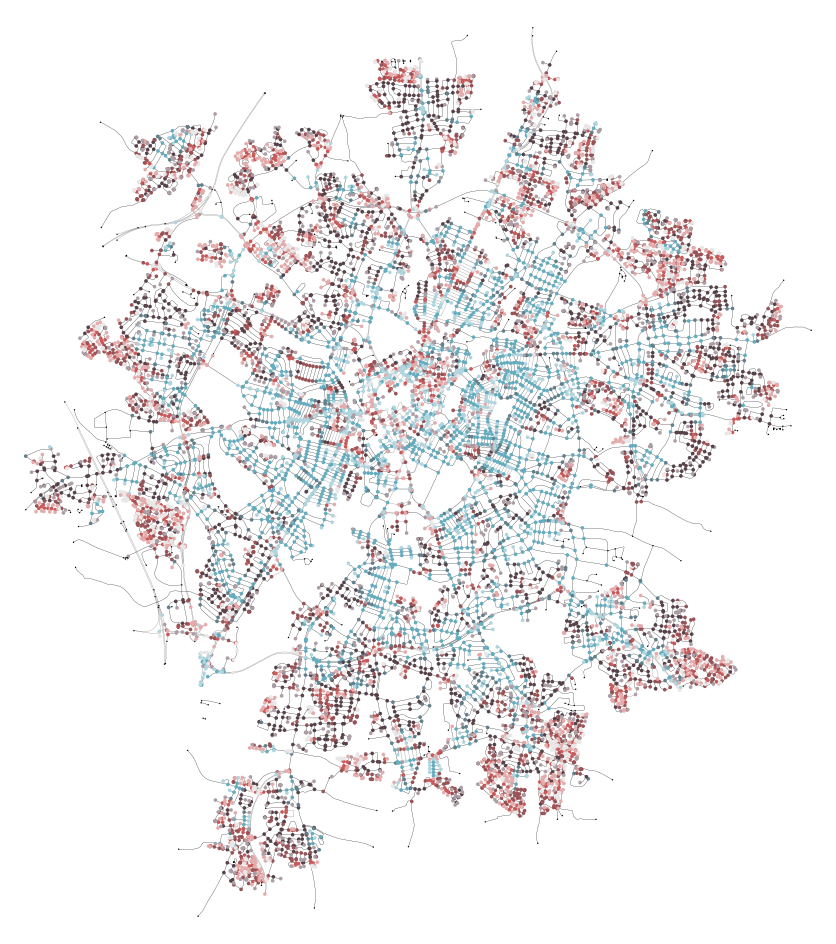GNNs ♥ Urban Form

Stefano De Sabbata, Andrea Ballatore, Pengyuan Liu and Nicholas J. Tate
Exploring urban form through graph neural networks
Graph theory has long provided the basis for the computational modelling of urban flows and networks and, thus, for the study of urban form. The development of graph-convolutional neural networks offers the opportunity to explore new applications of deep learning approaches in urban studies. In this project, we explore the use of an unsupervised graph representation learning framework for analysing urban street networks (see methods and code below).
Our preliminary results (see results and supplementary materials below) illustrate how a model trained on a 1% random sample of street junctions in the UK can be used to explore the urban form of the city of Leicester, generating embeddings which are similar but distinct from classic metrics and able to capture key aspects such as the shift from urban to suburban structures.
We presented v0.5 of the model at the 2nd International Workshop on Geospatial Knowledge Graphs and GeoAI: Methods, Models, and Resources (GIScience 2023, September 12th, 2023, Leeds, UK).
Stef presented v0.12 of the model as a lightning talk at the Turing Urban Analytics meeting on Transforming Urban Living with AI and Digital Twins (November 12th, 2024, Glasgow, UK).
Data
We used the Global Urban Street Networks data made available by Geoff Boeing, which include simplified street networks of 138 cities in the UK derived from OpenStreetMap.
Methods and code
All the code used for this project is available on our GitHub repo. The conda environment used for the project is described in this yml file.
We developed a graph autoencoder model using PyTorch Geometric. The encoder (see gnnuf_models_pl.py) is composed of five steps: one MLP projects the input node attributes into a large 256-dimensional space, three steps using modified graph isomorphism operators designed to incorporate the edge attributes in the aggregation step of the convolution, using 256 hidden features; and a final MLP layer, which reduces the 256 hidden features to 2 embeddings. The decoder is a standard inner product operator.
To train our model (see gnnuf_train_model_v0-12.py), we randomly sampled 1% of the nodes from 139 cities in the UK.
To evaluate the model, we used it to generate embeddings for all street junctions in Leicester – see gnnuf_embedding_model_v0-12_Leicester.py for node embeddings and gnnuf_embedding_model_v0-12_Leicester_pool.py for embeddings pooled at node ego-graph level – and Glasgow – see gnnuf_embedding_model_v0-12_Glasgow.py for node embeddings and gnnuf_embedding_model_v0-12_Glasgow_pool.py for embeddings pooled at node ego-graph level,
In our preliminary analysis (see results and supplementary materials below), we qualitatively explore the expressiveness of the model through a series of plots and maps, and we quantitatively compare the embeddings with closeness and betweenness centrality, both based on the whole city graph and based on the node’s ego-graph (see osmnx_stats_node_centrality_with_egograph_Leicester.py), as well as basic statistics (as provided by OSMnx) for each node’s ego-graph (see osmnx_stats_egograph_basic_Leicester.py).
Results and supplementary materials
The pages below present the main results obtained from our analysis as a jupyter notebook compiled to html, alongside an additional quarto document.
- Exploratory analyses of the results obtained for Leicester
- Exploratory analyses of the results obtained for Glasgow
Future work
Our preliminary results illustrate the potential of GNNs to develop an unsupervised framework to capture and explore urban form, but a more thorough exploration of the design space is necessary.
In our future work, we aim to expand the use of our framework in three aspects. First, we aim to explore the adaptability and usefulness of our approach through space, time and scale, testing how models behave when using a continental or global dataset for training, including past street networks or limiting the training to cities of the same scale as the target one(s). Second, we will explore how to encode places beyond junctions, including buildings or points of interest. Third, we will explore how to encode flows beyond networks, including commuting or communications.
Acknowledgements
The authors acknowledge the work of OpenStreetMap contributors and Geoff Boeing in creating the data that made this work possible. This research used the ALICE High Performance Computing Facility at the University of Leicester.